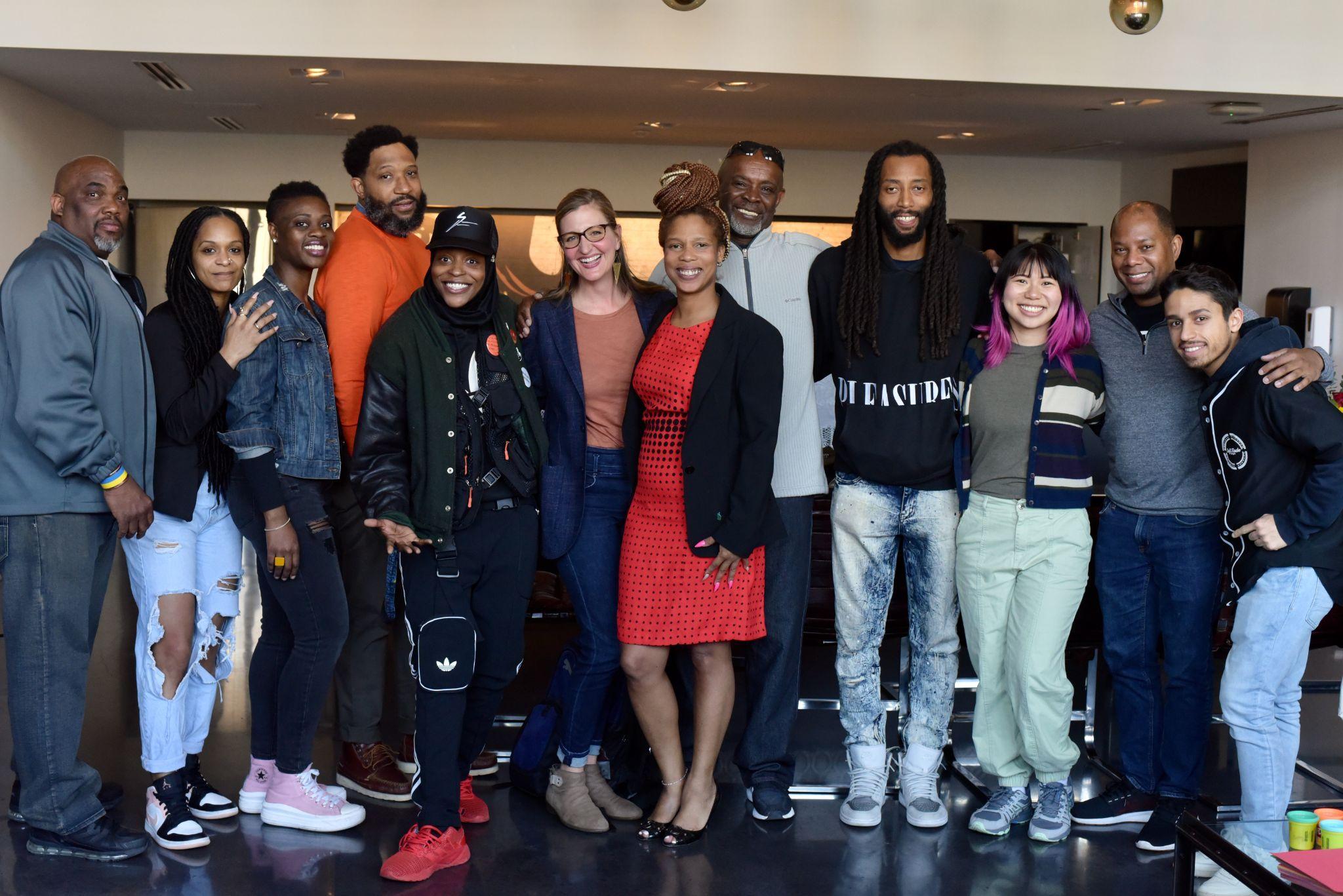

AboutUs
AzizaRobinson-Goodnight
An avid artist, educator, activist, entrepreneur and community organizer, Aziza is a woman committed to shaping, reenergizing and creating systemic, sustainable changes. She knows that communities need artists and could not survive without a creative perspective. Sitting on multiple boards and advisory committees for city and community development, she sees firsthand how difficult and beautiful change can be. The daughter of Paul Goodnight, famed painter and entrepreneur best known for his vibrant depictions of Black culture around the world, andemployeeofthefamily-ownedbusinessColor Circle Art Publishing Inc., she was born into the arts, having grown up in the Piano Factory, a historical art-space well noted foritsartistlivingspacesandartsadvocacy.AgraduateofHBCU Hampton University, she has spent her time since graduation serving communities of color Boston has been the base for her activism from serving as Chair of the upcoming Frederick Douglass SculptureProject(2011-Present)tosittingontheexecutiveboardoftheBostonBranch NAACP as the Chair of the ACT-SO Committee(2012-2016),andnowthefundraisingchairfor Transformative Culture Project. Previously she taught Arts and Ethics and was the Director of Afterschool and Enrichment atDavisLeadershipAcademy,DirectoroftheJerichoRoadProject, and was the managing partner offormer“Gallery-Z”onDudleywhichisbothanartGalleryand communityteachingspace,whereyoungpeopleareattheheartofalldecisions.
Dr. Moore is an ethnomusicologist and Faculty Scholar for the Institute for Health Equity and Social Justice Research at Northeastern University with research interests in music and environmental justice, artists as essential health workers, and community-engaged teaching and research. Her public sector roles have included cultural diplomacy programming and HIV/AIDS education, and she is co-founder of Bersama Project (the Together Project), Indonesian nonprofit empowering artists to campaignagainst gender-basedviolenceandforLGBTQ+rights.
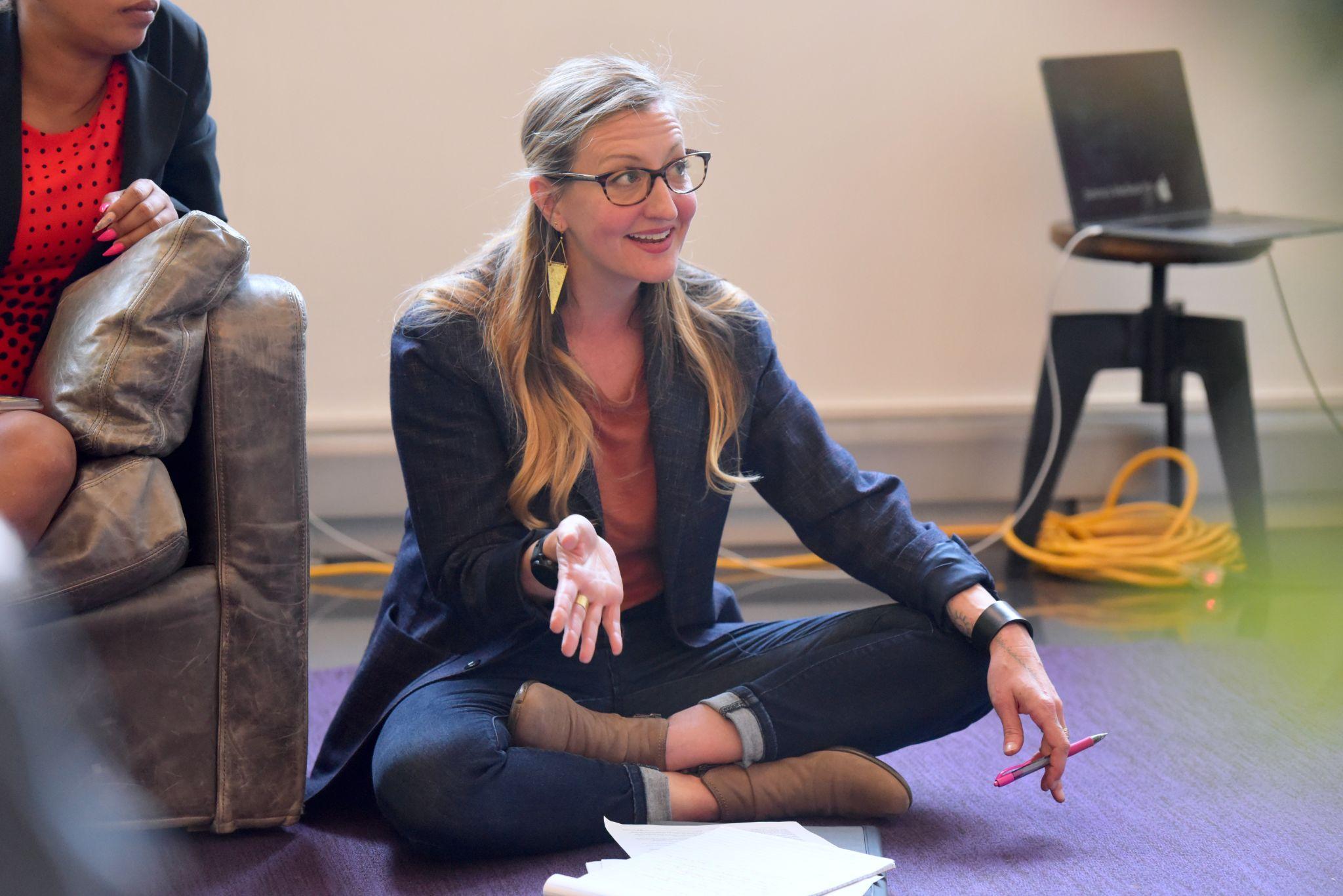
Photoscredit:VaniaArroyo
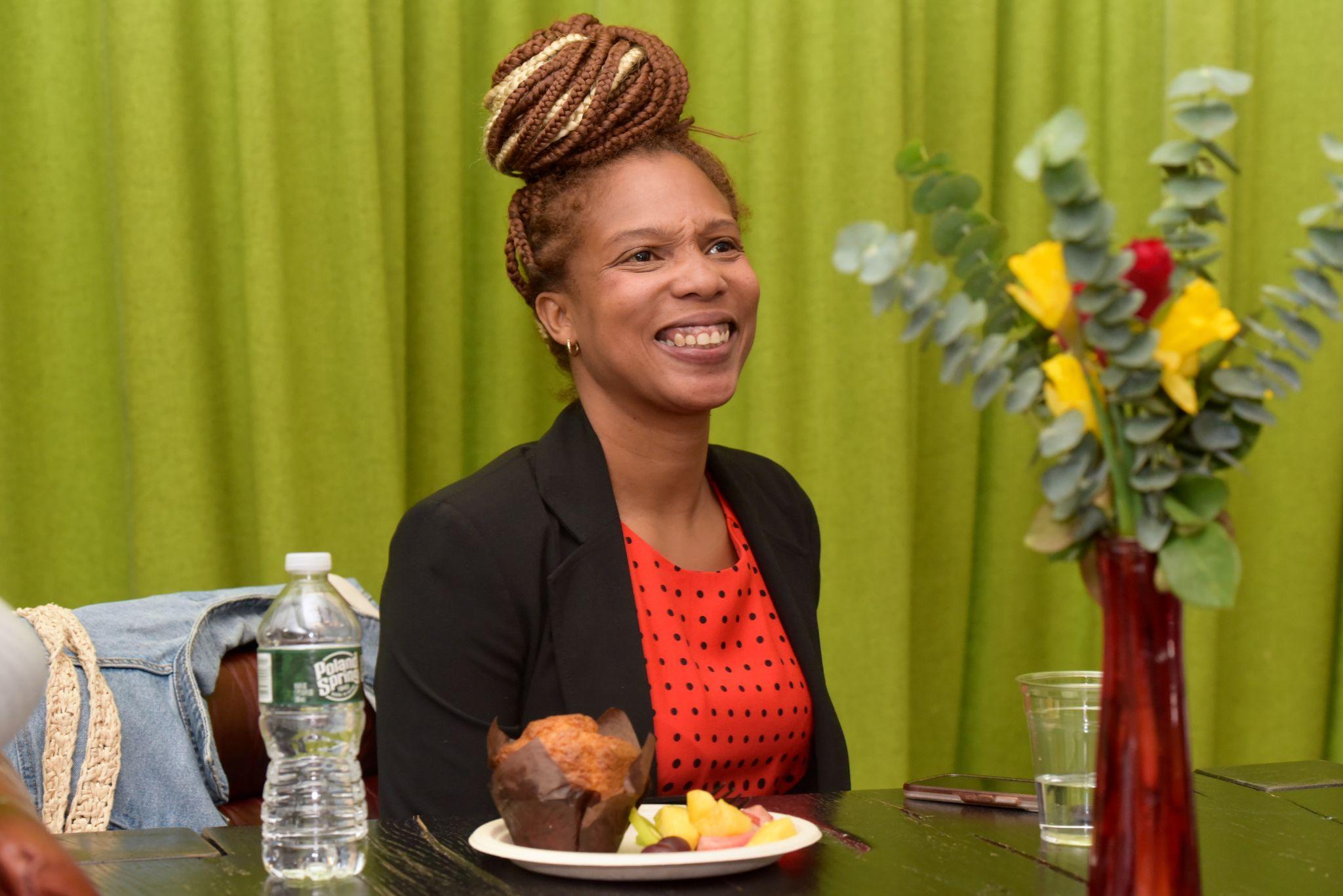
JordanRhyner
Jordan is Northeastern University Health Science undergraduate student and will graduate in May 2023. He has beenworkingclosely with Dr. Rebekah E. Moore as a Health Equity Intern through the Institute of HealthEquityandSocialJusticeResearchatNortheastern University since January 2021. With funding from the Office of Undergraduate Research and Fellowships at Northeastern, he investigated the potential for collaborations between artists and communityhealthcenters.
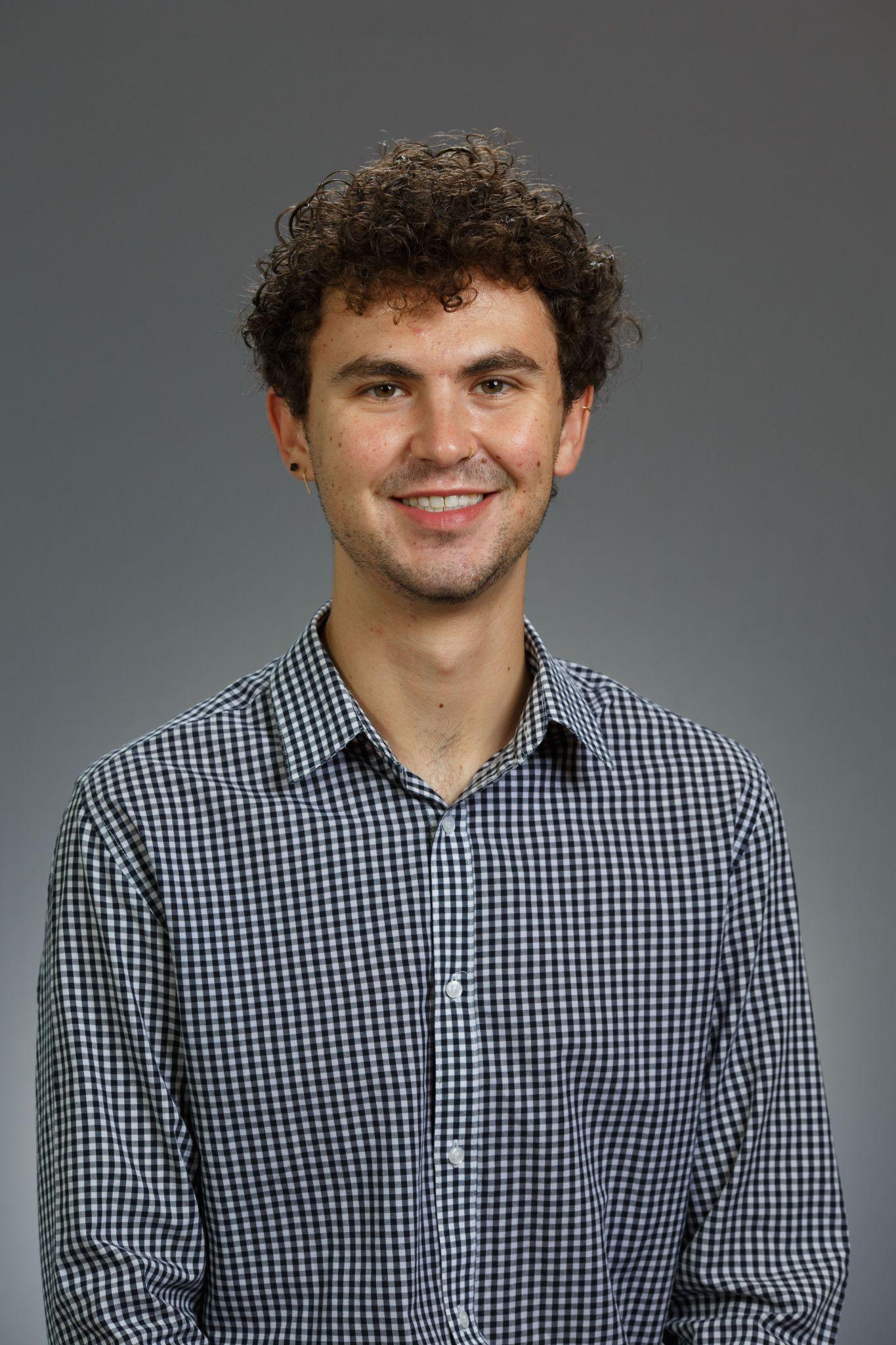
TaylorSmith,MPH
Taylor is theDirectorofEducationandTrainingat the Los Angeles Community Health Project overseeing the Overdose Education and Naloxone Distribution (OEND) program in collaboration with the Los Angeles County Department of Public Health’s Harm Reduction Division. She is passionate about harm reduction, substance use, and sexual and reproductive health. Working in community with marginalized peoples to imagine and create a more compassionate and equitable worldisherlife’spursuit.
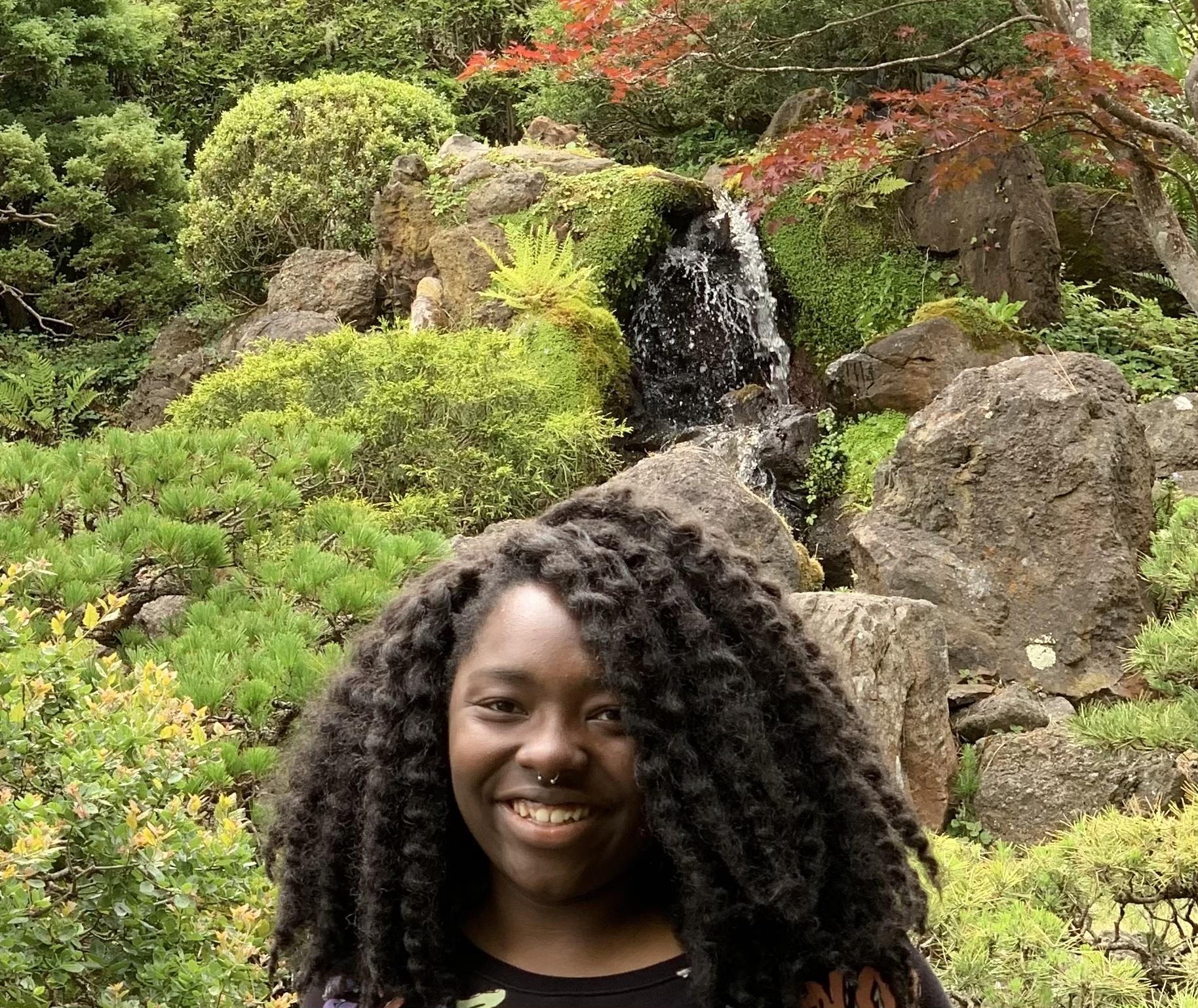
EXECUTIVESUMMARY
ResearchBackground
Art and culture are sources of emotional release, meaning-making, and social cohesion,and,ultimately,serveasprotectivefactorsforthehealthofcommunities.
Our two-year mixed-method study has explored the role artists play as essential public health workers in five Boston neighborhoods: Roxbury, Dorchester, Fenway, South End, and Jamaica Plain. We have examined disparate health outcomes in Boston neighborhoods, mapped the cultural assets in the city of Boston, interviewed artists and arts organizers, documented the socioeconomic conditions for artists of color, and explored the feasibility of partnerships betweenartistsandcommunityhealthcenters.
KeyFindings
- Involuntarydisplacementandracializedhealthdisparitiesareissuesaffectingresidentsin theBostonneighborhoodincludedinourstudy
- Artistsarenotreceivingsufficientcompensationtothriveintheneighborhoodswhere theyliveandwork.
- Thelackofaffordableandreliablestudiospaceshindersartistsfromcreatingandisa contributingfactortotheinvoluntarydisplacementofartistsinBoston.
CallstoAction
- Artistsshouldbeconsideredessentialpublichealthworkers,especiallyincommunities thatexperiencehealthdisparities.
- Artistsneedtechnicalsupporttoaccessgrantsandstudiospace.
- Collaborationsbetweencommunityhealthstakeholdersandpublichealthresearchers needtobeprioritizedinordertolearnmoreabouttheartist'sroleincontributingtothe healthoftheircommunity
- Physicalspace,ownedbyartistsandartsorganizers,dedicatedtoprovidingahealing experienceforneighborhoodresidentsandhealthprofessionalswillenhancethehealthof communitiesexperiencinghealthdisparities.
INTRODUCTION
Racializedhealthdisparitiesandinvoluntarydisplacementnegativelyaffecttheeconomic opportunitiesandwell-beingofBostonresidents.CommunitiesofcoloracrossBoston neighborhoodsareexperiencingdisparatehealthoutcomeswhichhavebeenexacerbatedasa resultoftheCOVID-19pandemic.ResidentsinhistoricallyBlackBostonneighborhoodssuchas RoxburyandDorchesterareexperiencinganinfluxofwhiteresidentsresultinginreduced opportunitiesforpeopleofcolortobuildwealththroughphysicalspaceownership.Infact,asof 2018,64%ofthewhitepopulationinGreaterBostonownedhomescomparedto30%ofBlack residents(BostonIndicators,2019).Whiteindividualscontinuetobeaffordedeconomic opportunitiesthatleadtobuildinggenerationalwealthwhileBlackresidentsarebeingpricedout oftheirneighborhoods.
Alongwithland,business,andhomeownership,creativeopportunitiesforpeopleof colorinBostonneedtobeprioritized.Artsandculturecontributetowell-beingfactorssuchas self-efficacy,personalandculturalresonance,emotionalengagementandempathy, meaning-making,andsocialcohesion.Theartscanbeatooltofacilitatehealingforcommunities ofcolorfromcollectivetraumabroughtuponbycenturiesofsystemicracismanddisparate healthoutcomeswithinandacrossneighborhoods.Thus,itisimperativethatartistsofcolorfrom Bostonneighborhoodshavetheopportunitytoliveandworkintheircommunities.
BostonNeighborhoodDemographicsandHealthOutcomes
DatafromtheBostonPublicHealthCommissionandtheCityofBostonDepartmentof NeighborhoodDevelopmentshowthat,oftheneighborhoodsofDorchester,Fenway,Jamaica Plain,andFenway,theBlackestneighborhoodsofRoxburyandDorchester(50.3%and44.0%, respectively)arethetwoneighborhoodswiththepooresthealthoutcomescomparedtoother neighborhoodsincludedinourstudy(BostonPublicHealthCommission,2019).Eachdotbelow indicatesthattheneighborhoodhadapoorerhealthoutcomethantherestofBostonforatleast onehealthindicatorwithinthe10healthdomains.
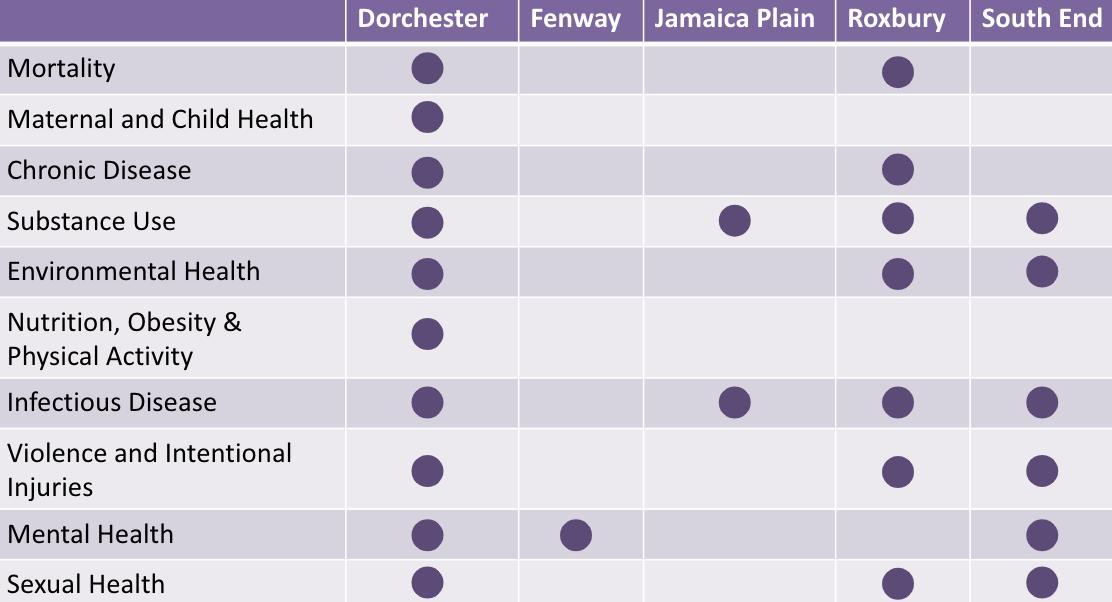
As of February 2022, data from the BPHC show thatCOVID-19 infection and death highlight racial health inequities in Boston. When stratified by race, peoplewhoidentify as Latinx/Hispanic have the highest COVID-19 prevalence in four out of five of the neighborhoods included in our study. In the last neighborhood, Fenway, the prevalence ofCOVID-19 is highest for people who identify as Black, non-Latino, and non-Hispanic (nL/nH). COVID-19PrevalenceinBoston2
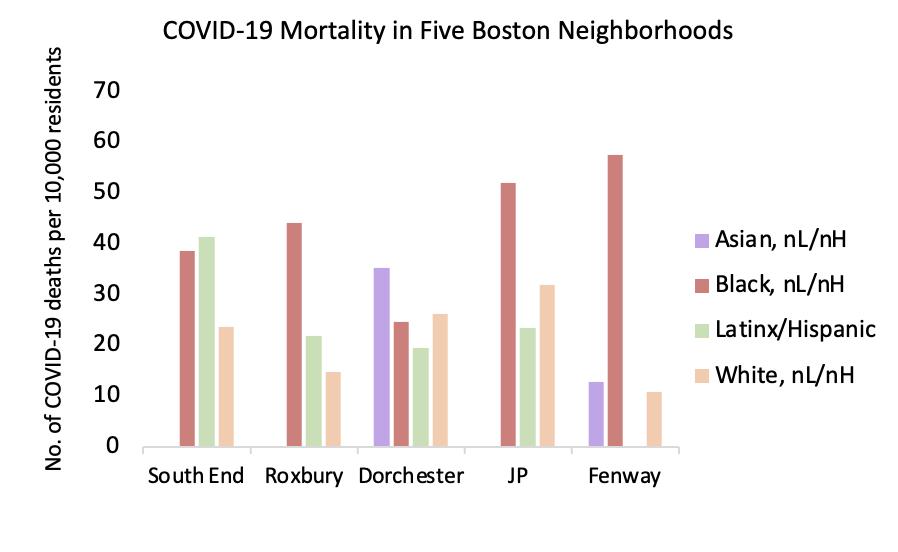
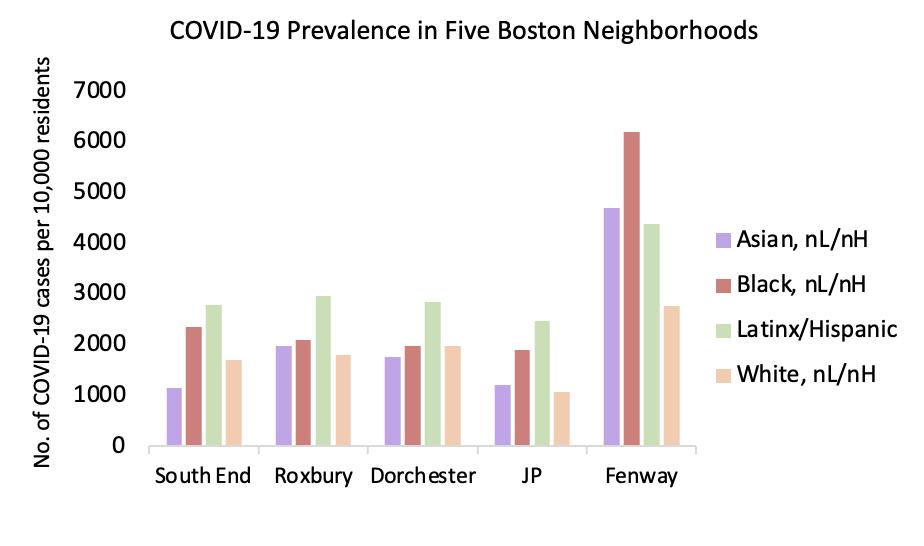


RegardingCOVID-19deaths, people who identify as Black nL/nH have the highest death rate in three out of five neighborhoods (Roxbury, Jamaica Plain, and Fenway). In Dorchester, people who identify as Asian nL/nH have the highest death rate in the neighborhood while in South End, people who identify as Latinx/Hispanic have thehighestdeathrate. COVID-19DeathinBoston2
The COVID-19 data provided by the BPHC further elucidate that people of color in Boston are experiencing inequitable health outcomes (See Appendix A for the full data set). Higher prevalences of COVID-19 suggest that isolation, financial burdens, and the grieving woven into the COVID-19 experience are more prevalent in communities of color. In the summer of 2020, two weeks after the murder of George Floyd, former Boston mayor Marty Walsh declared racism as a public health crisis (City of Boston Mayor’s Office, 2020). In accordance with this executive order, the collective well-beingofthesecommunitiesneedstobe prioritized. Supporting artists of color and valuing them as essential public health workers are steps towards contributing to the health of their neighborhoods and combatting the effects of generationaltrauma.
GentrificationandInvoluntaryDisplacementinBoston
HistoricallyBlackneighborhoodsinBostonsuchasRoxburyandDorchesterare experiencingawhiteningoftheresidentsandawideningofexistingwealthgaps.Theresidents intheheartofBlackBostonarebeingpushedout;in1980theBlackpopulationinRoxburywas at79%anddeclinedto53%in2010whiletheproportionofthewhitepopulationmorethan tripledduringthesametimeperiod(BostonIndicators,2019).InaninterviewwithTania Anderson,afashiondesignerandBostonCityCouncilwomanforDistrict7,shestatedthatsheis hopefulthat“we'llgettoapointwhereweshowthebeautyofourcommunityandwecanshare itequitablyasopposedtobeingpushedout.”Inneighborhoodswithanabundanceofcultural wealth,residentsareexperiencingincomeinsecurity,housinginsecurity,andhomelessness whichareallsocialdeterminantsofhealththatnegativelyaffectthehealthoftheseresidents.
CedricDouglas,avisualartistfromDorchester,definesahealthycommunityas“asafe communitywithsharedvaluesandissurroundedbyloveandbeauty.”TheresidentsofDouglas's homeneighborhoodofDorchesterarerichinhistoryandcultureyetareexperiencingrapid demographicchanges.Essentialtothehealthofthiscommunityisfortheresidentstobeableto liveandworkwheretheywereraisedwhichcanbeinitiatedbybolsteringeconomic opportunitiesandfosteringsafeenvironments.Creatingopportunitiesforartistsofcolorisone waytoaddressthechallengesthatcomewiththedemographicchangesofneighborhoodswhose residentsareexperiencingdemographicchangesandinvoluntarydisplacement.Asthe changemakersandvisionariesofthecommunity,artists’talentscanbeutilizedtousherina communitythatDouglasenvisions.
ArtsEngagementasaPublicHealthIntervention
Theuseofartasacomplementaryformofhealthcareisanideathathasbeenaroundfor decades.Arttherapypracticesthatarewell-knownincludemusictherapyandarttherapyclasses. Inasimilarvein,familiarmethodsofhealthpromotionthatincorporatecreativeexpression includehandwashingpostersandmask-wearingcampaignsthroughouttheCOVID-19pandemic. However,theroleofartinpromotingequitablehealthoutcomescanbeappliedonamuch broaderlevelasartistsplayaroleinshapingourreality,andourindividualandcollectivesense ofself-worth,identity,andbelonging.
Groundedinthesocial-ecologicalmodelofhealthwhichtakesintoconsideration individual,relationship,community,andsocietalfactors,theArts&CultureinPublicHealth frameworkprovidedbytheUniversityofFloridaCenterforArtsinMedicinelinksartsand culturetospecificmechanismsthatdrivepublichealthoutcomes(Sonke&Golden,2020). Outcomessuchasincreasinghealthserviceequity&access,creatingsafeenvironments,and supportingsocialandpolicychangeareallwaysinwhichartistscancontributetothehealthof theircommunities(seeAppendixBforallmechanismsandoutcomes).
TheoutcomesdescribedintheArts&CultureinPublicHealthframeworkcanbeapplied todocumentedcaseswheretheartshavebeenutilizedtoaddressupstreamsocialdeterminantsof health.Take,forexample,aphotographyprojectforyouththatsupportedsocial,cultural,and policychangebyenablingdialoguewithinandacrosstwocommunitiesinIsrael(Baderetal., 2007).Or,acommunitydramaprojectinwhichpeoplerecoveringfromaddictionwereprovided withasafeandengagingspacetoexplorerecoverythemes(Kewley&VanHout,2020).Bothof thesecommunityartprojectsresultinoutcomesthatalignwiththeaforementionedframework. Thebasisoftheseprojectscanbeusefulinprovidinginsighttocreatecreativeopportunitiesin Bostonwiththegoaltoaddressracialhealthdisparities.
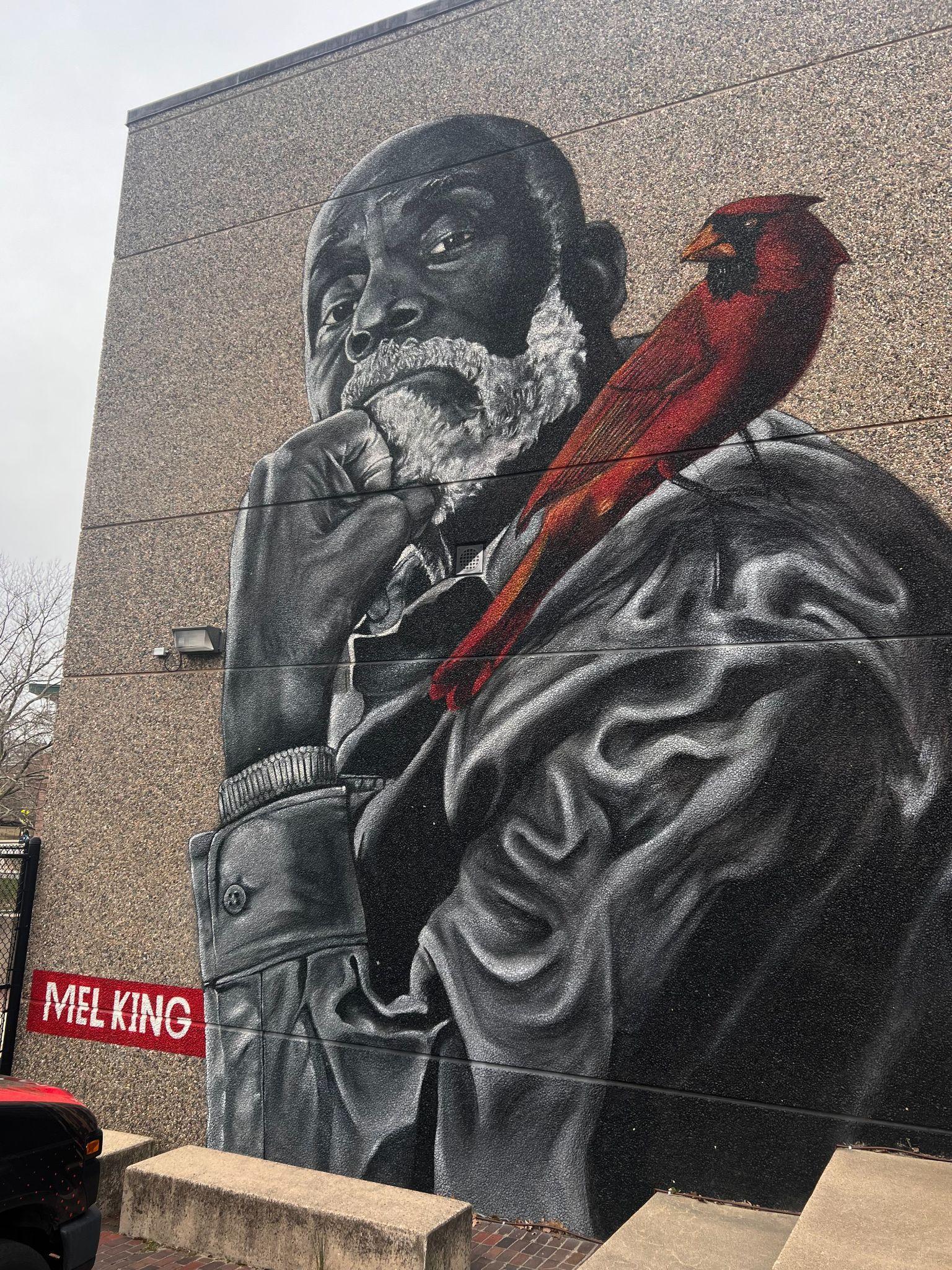
Acknowledgingartandcultureasessentialfactorsforimprovingpublichealthhastaken rootinMassachusetts.ThevisionoftheCultureRxInitiativeis“aCommonwealthwhereculture isunderstoodasanessentialinvestmentinhealth”(MassCulturalCouncil,2022).Theideaof socialprescriptioniscentraltothisprogramwhereculturalparticipationisencouragedto improvehealthoutcomes.However,explicitstepsneedtobetakensothatprogramslikethese canbebeneficialforcommunitiesofcolorthatexperiencehealthdisparitiesinBoston.
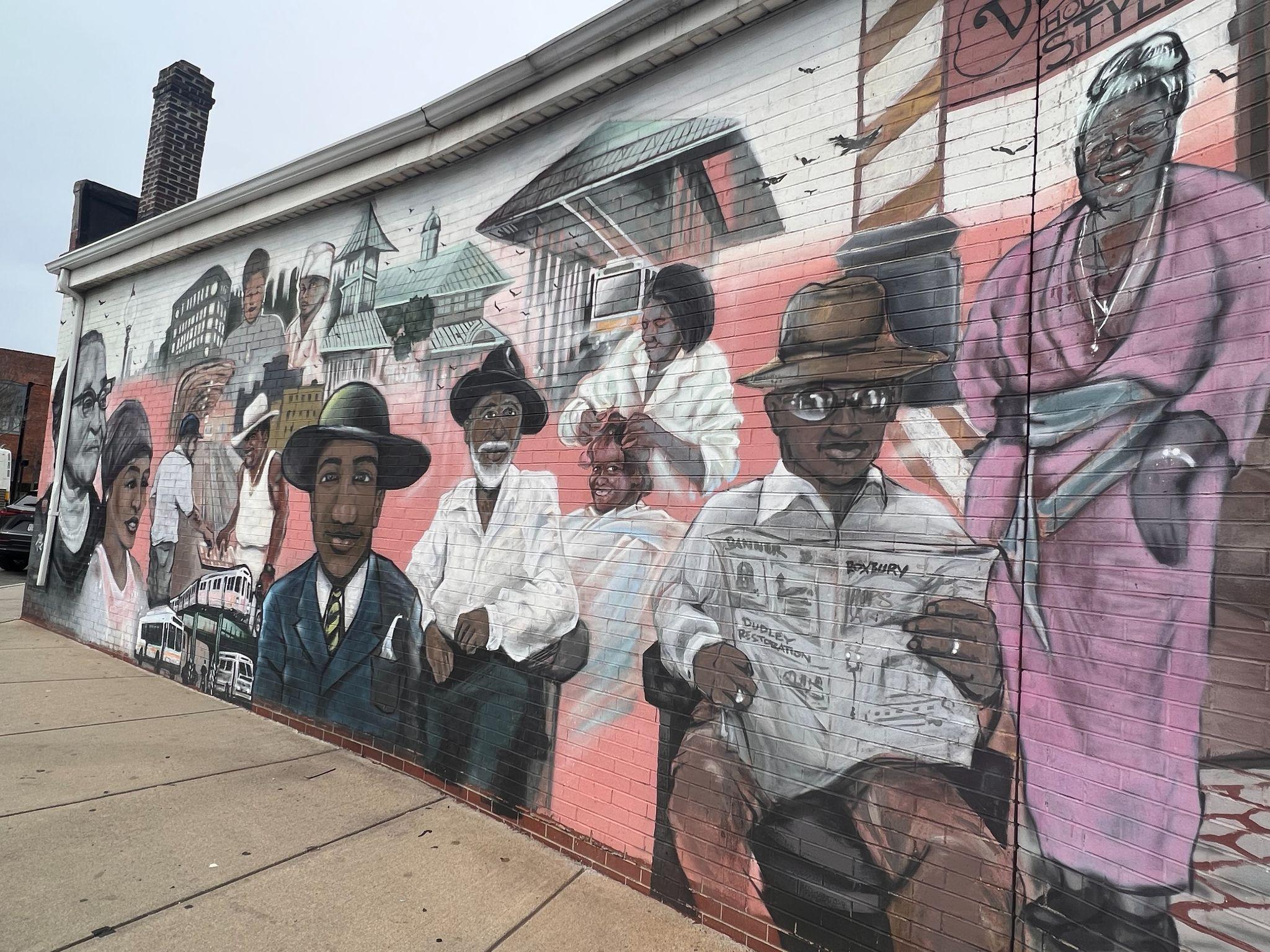
Purpose
Thiswhitepaperequipspublichealthprofessionals,grassrootscommunityadvocates, andpolicymakersatthecity,state,andnationallevelswithinformationaboutthedisparate healthoutcomesinBostonandhowartistscanaddresssocialdeterminantsofhealth.Researchers atacademicinstitutionsandartistsmayalsofindthispaperinsightfultocreatesustainable, community-engagedresearchpartnershipsbetweenmembersofhighereducationinstitutionsand artists.Lastly,weaimtoempowerhealthcareprofessionalssuchascommunityhealthworkers andclinicianswithinformationonhowtoembracetheworkofartistsasessentialpublichealth workersinthelivesofcommunitymembers.
BACKGROUND
TraditionalArtInterventionsvs.UpstreamHealthArtInterventions
TheoriginsofarttherapycanbetracedbacktoMargaretNaumburg’sclinical publicationsintheUnitedStatesandAdrianHill’scoiningoftheterm“arttherapy”inEngland in1942(Junge,2016).Althoughcreativeexpressionsastherapeuticritualsdatebackcenturies, thewideacceptanceofaprofessionalfieldfortheintegrationofartisticexpressioninclinical settingscanbeattributedtotheworkofNaumburgandHill.Morerecently,itisgenerally recognizedthatarttherapyenhancescommunicationandimprovesself-esteem(Bitonte&Santo, 2014).Forexample,itiscommonforpatientssufferingfromhealthissuessuchaschronicillness andmentalhealthchallengestoparticipateinarttherapyasapartoftheircareplans.However, wenowknowthat,althougharttherapyisbeneficialforindividualsexperiencinghealth challenges,theartsalsocanbeimplementedtoaddresstheupstreamdriversofhealth.
Activeparticipationandengagementintheartscanpositivelyshapetheupstreamsocial determinantsofhealth,whichisespeciallyimportantinareasexperiencingvarioushealth disparities.AsdescribedintheUniversityofFlorida's“ArtsandCultureinPublicHealth:An Evidence-BasedFramework,”mechanismssuchasself-efficacy,emotionalengagementand empathy,meaning-making,andself-transcendenceleadtooutcomessuchasincreasinghealth serviceequityandaccess;creatingsafe,inclusive,andengagingenvironments;andsupporting social, cultural,andpolicychange(Sonke&Golden,2020).Themechanismsofthisframework mediateormoderatetheoutcomeswhichreflectareasofindividual-andpopulation-levelhealth indicatorsthatcanbeinfluencedthroughtheinvolvementofthearts.Theworkofourresearch focusesontheupstreamdriversofhealththattheartscanprovideandtherichcollaborationsthat canbedevelopedbetweenartistsandpublichealthresearchers.
TheImpetusofOurResearchontheIntersectionofArt,Race,Place,and HealthEquity
Two interrelated events provide context for the collaboration between Northeastern researchersandmembersofBoston’sartisticcommunity:
1) RacistAttacksonDorchesterMiddleSchoolStudents
In 2019, racist remarks and actions by staff at the Museum of Fine Arts (MFA) against students, which Aziza Robinson-Goodnight previously worked with from the Helen Y Davis Leadership Academy (DLA) inDorchester,leftstudentsfeelingharassedanddisrespectedonthe basis of their skin color. The teachers fromDLAintendedfortheseventh-gradestudentstohave an enriching experience as a part of their arts and ethics class; however, they ended up being racially profiled at the majority-white institution. The racially insensitive comments were traumatic for the students and the teachers. This distressing experience for the Black middle school students is of significant importance to thisprojectbecauseitisarepresentationofBlack youthbeingexcludedfromplacesthatcelebratetherichnessofcreativeexpression.
Although the area surrounding the MFA is commonly associated today with the majority-white Fenway neighborhood, we are reminded by Boston natives such as Barrington Edwards, a visual artist from Dorchester and professor at the Massachusetts College of Art and Design, that, “Mass Art and the MFA are actually in Roxbury.” The changes in neighborhood associations over the years for the area surrounding the MFA spotlight the mutations that the neighborhood has experienced as demographics change over time. Our research aims to document how changes in neighborhood associations, neighborhood demographics, and the availability of resources affect the health of communities in Boston that are disproportionately affectedbygentrificationandinvoluntarydisplacement.
2) Northeastern University’s Eviction of Elder Artists from the African American Master ArtistsinResidencyProgram
A year after the MFA incident, the administration at Northeastern Universityshutdown artist studios and locked out members of Northeastern University’s African American Master Artists-in-Residence program (AAMARP) (Mason, 2020). In response to the lock-out, supporters of the program rallied outsidethestudiospaceinJamaicaPlain.TheAAMARPdates back to the 1970s when Black
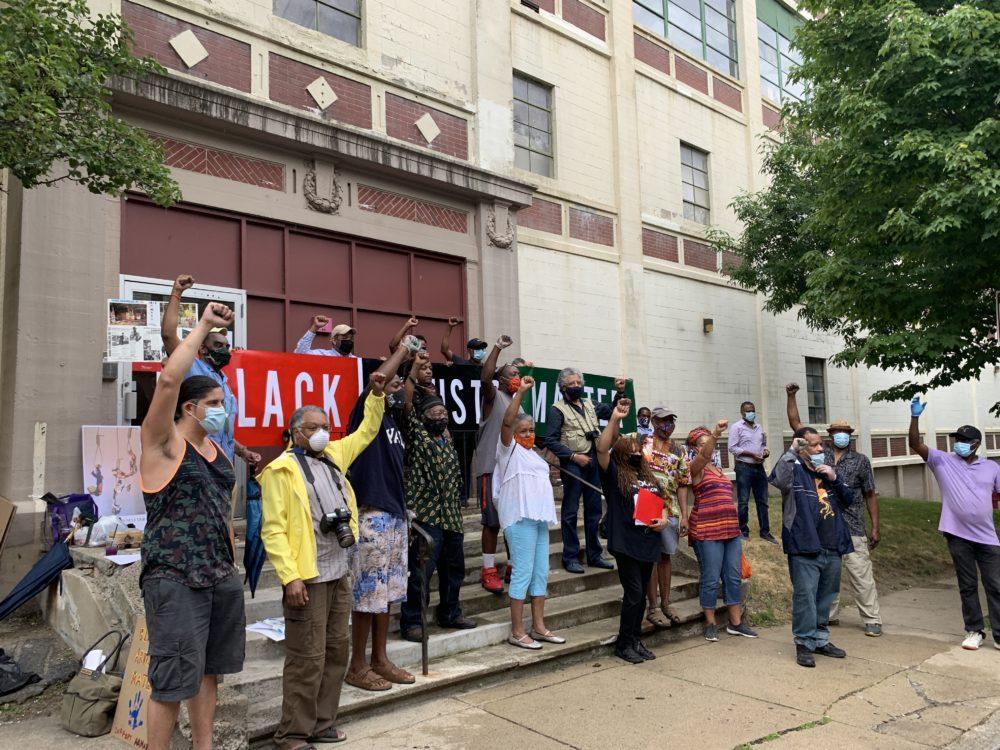
Power artist Dana C. Chandler received studio space from Northeastern University and became thefirstAfricanAmerican artist-in-residence program in the United States. The lockout of Black artists in Boston’s Jamaica Plain neighborhood embodies a denial of creative spaces for communities of color Our research aims toincreaseaccessto spaces for artists of color and increase ownership of space, such as studios, by artists of color so that events like this one are not repeated.
Thetwoeventsaboverepresentthewaysinwhichthetraumasofracismaffectallgenerations withincommunitiesofcolor.Thus,isessentialtoadoptanintergenerationalapproachwhen learningabouttheprioritiesanddevelopingsolutionsforthesecommunities.
ResearchTrajectory
Tier-1 Grant
TheexploratoryphaseofthisresearchwasfundedthroughaninternalNortheastern UniversityTier-1grantin2020andawardedtoRebekahMoore.Alsoincludedinthisgrantas co-principalinvestigatorswereAmandaReeserLawrence,AlisaLincoln,ShanMohammed, AntonioOcampo-Guzman,andLauraSenier.Duringthisphase,literaturereviews,neighborhood healthoutcomeanalyses,culturalassetmapping,30+ethnographicartistinterviews,andanartist focusgroupgeneratedknowledgeonartandchallengesthatartistsfaceinRoxbury,Dorchester, SouthEnd,Fenway,andJamaicaPlain.Theaimoftheexploratoryphasewastoprovideabasis ofknowledgeforresearcherstoinvestigateartsparticipationasapublichealthintervention.
30+ Ethnographic Artist Interviews
TogainasenseoftheculturalassetsinthecityofBoston,31artistsandartsleaderswere interviewedacrossvariousartisticgenresincludingbutnotlimitedtovisualartists,musicians, photographers,andfashiondesigners.Afewquestionstheartistswereaskedincludehowthey describetheirrace/ethnicity,creativemedium,theneighborhoodtheyliveandworkin,anda healthycommunity.TheartistquestionbankcanbefoundinAppendixCandtheartsleader questionbankcanbefoundinAppendixD.TheinterviewswereledbyAziza Robinson-Goodnightasaco-researcherandprovidedaricherunderstandingofthecultural ecosysteminBostonandthehealthoutcomesthataremostimportanttotheresidentsofthese neighborhoods.
Artist Focus Group
This focus group united artists, public health researchers, and activists to answer one central research question: How might increasing the professional opportunities for artists and access to the arts supportthehealthandwell-beingofBoston’smanycommunities—particularly those that have been historically marginalized, oppressed, ordisinvested?Theexploratoryphase of our research yielded research gaps in evidence-based art and public health studies, called attention to the breadth and diversity of BIPOC art in Boston, and brought some clarity to the interrelated socio-economic and health challenges facing artists of color and their communities. In this gathering ofcreativeminds,westartedaconversationtogether,withanaimofidentifying the next steps to translate this research into action to advance art, race, and health equity in the CityofBoston.
Presentation
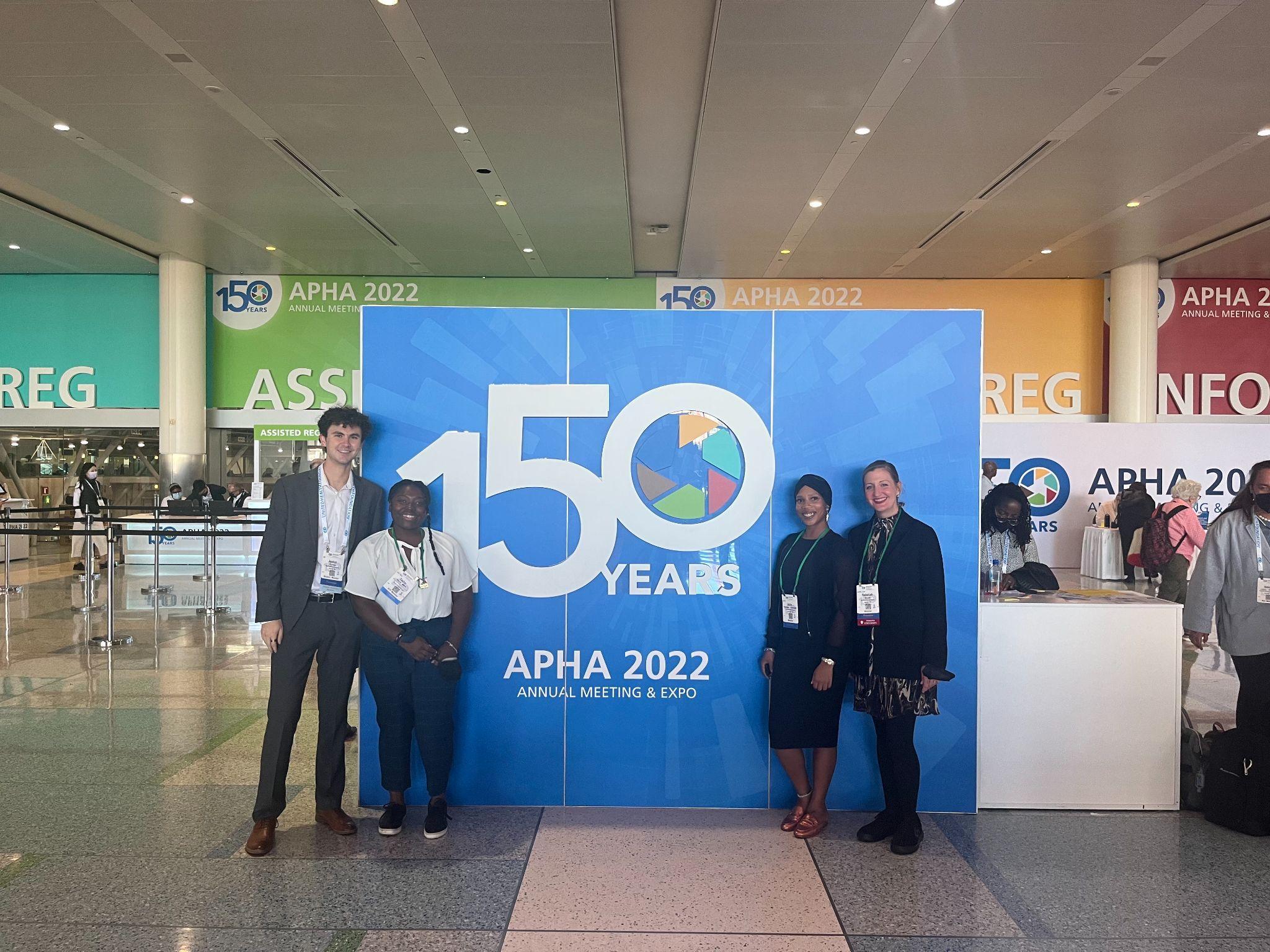

withtheknowledgefromthe mixedmethodstudy,ourteam attheAPHAAnnualMeetingin MA.Thepresentation,entitled EssentialWorkers:Researchat IntersectionofArt,Race,andHealth theCityofBoston,”sharedwhat aboutartists'rolesinshapingthe determinantsofhealthandwell-being Additionally,weadvocatedfor theartsinpublichealthresearch emphasizingtheimportanceof collaborationswithartistsasco-researchers, changemakers,andessentialpublic workers.

Artist and Community Health Center Focus Group Interviews

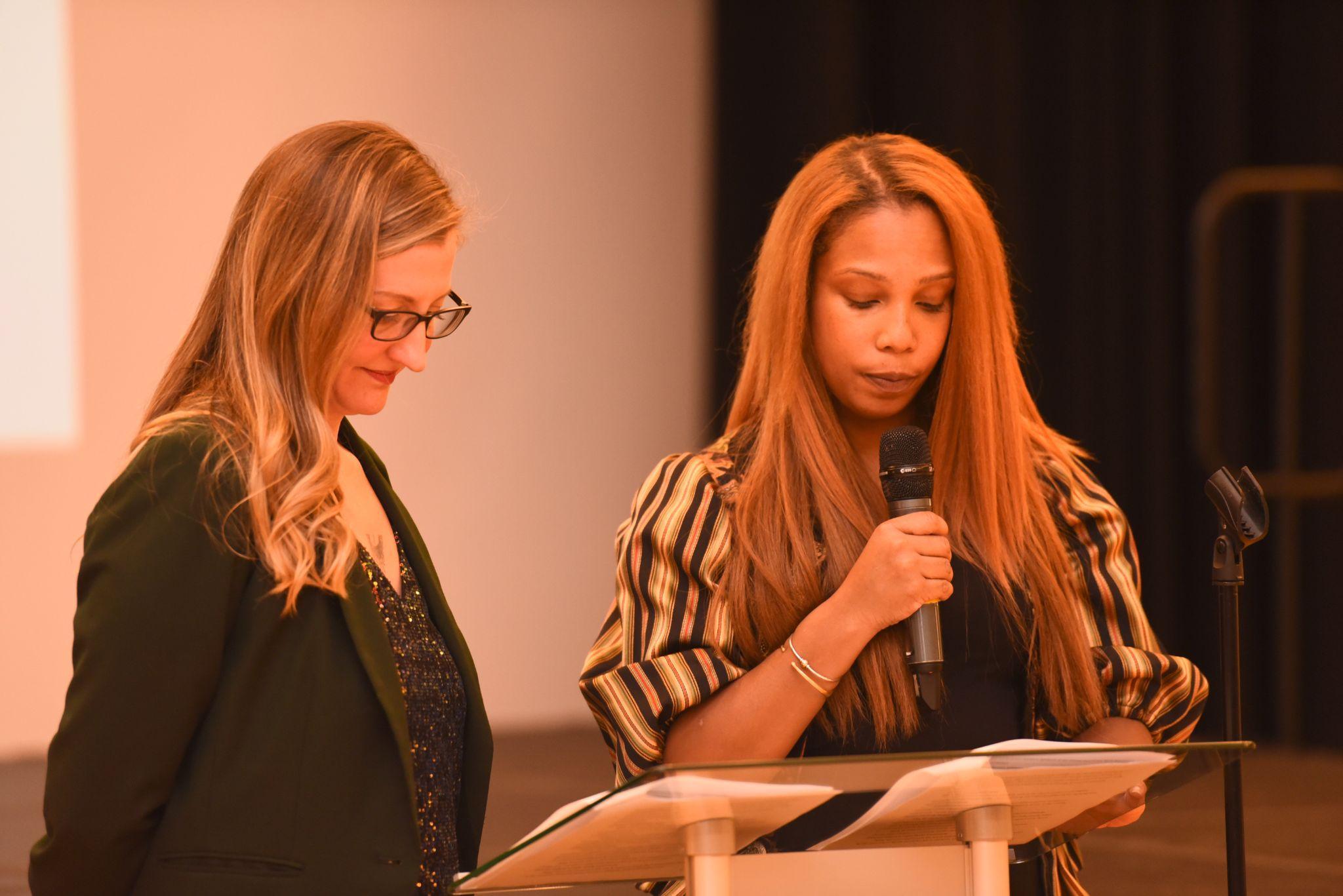
Feasibilityfocusgroupinterviewsconsistingofresearchers,artists,andcommunity healthcenterrepresentativesinvestigatedpotentialcollaborationsandthepossibilityof co-locatinghealthservicesandartsparticipation.Inthefocusgroupinterviews,participants discussedprioritiesfordevelopingpartnershipsbetweenartistsandcommunityhealthcenters, theresourcesthatarenecessary,andwhythesepartnershipsareimportantforthecommunity Followingtheseinterviews,aWinterSolsticeCommunityCelebrationwasheldinDecember 2022atHibernianHallinRoxburytobringtogethercommunityleaders,artists,andhealth workers.Thiseventsharedthefindingsoftheresearchwiththecommunityandadvocatedfor artistsasessentialworkers.
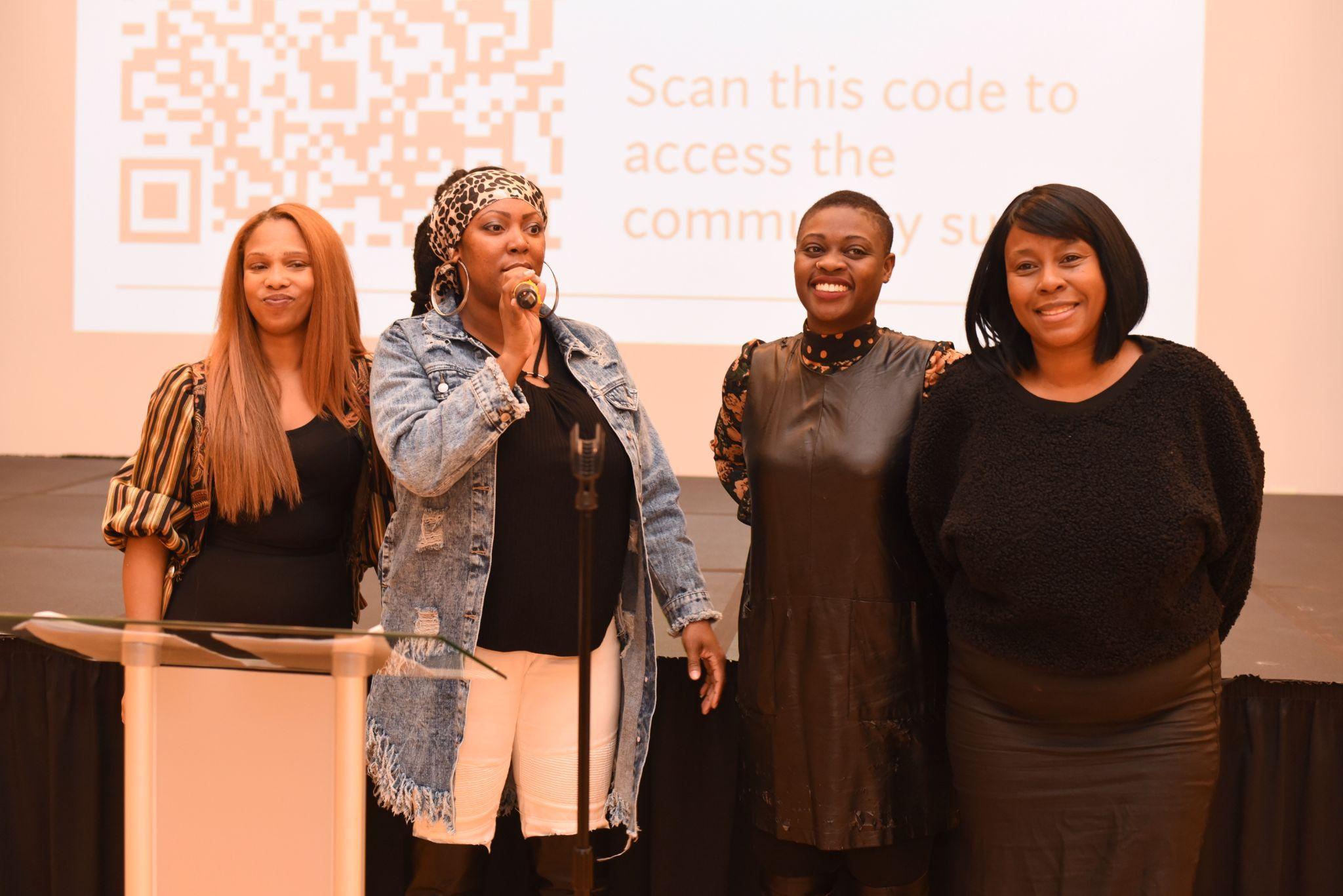
KEYFINDINGS
ArtistVoicesShapingtheHealthofTheirCommunities
Duringtheexplorationphaseoftheresearch,31artistsandartsleadersfromthe neighborhoodsincludedintheTier-1studywereinterviewed. Intheseinterviews,the intervieweedescribedtheirraceandethnicity,neighborhood,artform,andhowtheydescribea healthycommunity(SeeAppendixCandDforinterviewquestionbanks).Then,theinterviews weretranscribedandcodedusingtheUniversityofFloridaArtsandCultureinPublicHealth Frameworkevidence-basedoutcomes.Thefollowingaresamplesfromsevenartistsofthe individual-andpopulation-levelhealthoutcomesdiscussedintheartistinterviews;theexcerpts serveasartistcommentsonthehealthoftheirneighborhoodsandguidethedirectionofthe researchcoalitionbetweenartistsandinstitutionalacademicpartners.
IncreaseHealthServiceEquity&Access
Outcome: Increased racial & social equity
TheinspirationforAmandaShea’sworkasamultidisciplinaryperformingartist “derivesfromgenerationalhealing,generationaltrauma,identity,gender,socialjusticeissues.” Sheareferstoherselfasan “artivist,”shesays,“becausemyartismyactivism.”
Outcome: More welcoming and inclusive spaces
AntThomas,amusician,writer,andproduceroriginallyfromSouthEnd,describesa healthycommunityas,“Onewherepeoplesharevaluesthatbenefiteverybody.Wherethere's sharedleadership,diverseleadership,diversethought,access,transparency,andlove.”
EphSee,arecordingartistfromDorchesterandouryoungestartistparticipant,describes thehealingworkofanartistas“beingabletoacknowledgeandrecognizethesimilaritiesthatwe have,whetherit'sanexperience,whetherit'sanidentity,whetherit'sinourhopesandgoalsfor thefuture.”
CreateSafe,Inclusive,&EngagingEnvironments
Outcome: Spaces for learning, connection, & play
PainterShirleyFangfromtheSouthEndponders,“whenIthinkoflikeahealthy community,Ithinkofacommunitythatheals.Ithinkofhowwellnessshouldbepartofthecore curriculum,likeourcapacitytohealeachother.”
VisualartistCedricDouglasfromDorchesterdescribeshisrelationshipbetweenhisart andtheaudience:“Iwanttoconnectwithpeoplenotjustforpeopletoseetheartandappreciate it,Iwanttohavemoreofaconnectionwhereit'salmostlikethiskindofsymbiotic,likekindof sharedrelationshipwhereI'mtalkingtomyaudience.”Hefurtherexpressesthat“ahealthy communityisasafecommunitywithsharedvaluesandissurroundedbyloveandbeauty.”
Outcome: Growing & aging in place
ShirleyFangdescribesahealthycommunityas“aspacetocreate,aspacetogrow,and tobeaccepted.”
EchoedbyJaypix,aphotographerfromDorchester,theyexpress“Ithinkthat's important,youknow,alsotoourlike,ourhealth,ourwell-being,youknow,notwantingtoleave ourspacesandgosomewhereelse.Wecancreatespaceherewitheachother Andtrytosustain ourbusiness.”
SupportSocial,Cultural,&PolicyChange
Outcome: Enable dialogue within & across groups
VisualartistandDorchesternativeCedricDouglascallshimselfa“social interventionalist”whoseworkasanartistreflectsthevoicesofthecommunity.Douglasexpands that“theconversationswehaveareusedtohelpmedevelophowtheartiscreated.Sothat'skind ofwhyIsaysocialinterventionalist.”
Outcome: Elevate underrepresented voices
Asastrongfigureforhowartistsusetheirworktosocialinjustices,AmandaShea describesherwork“asawayofamplifyingnotonlymyvoice,butthevoicesofothers.”
Outcome: Organize & mobilize communities
Anessentialsteptocreatingsocial,cultural,andpolicychangeistohavechangemakers thatknowhowtoengagetheirneighborhood.Speakingonherroleasanartist,AmandaShea says,“Ifeellikethat'sourjob,liketotalkaboutitwithinourarttoincitepeopletogetexcited aboutitandwanttodosomething.”
EnrichResearchMethods&Practices
Outcome: Illuminate community needs and priorities
Jaypixreportsthatitis“importantforustobeabletoreflectwhatwewantandwhatwe needinourcommunity.”
Whendiscussinghisownartsprogramming,JamesPierre,communityartsorganizer andfounderoftheAdiusArtsCollective,explainstheimportanceofincludingartistvoicesfrom Roxbury,aneighborhoodwherehewasinterestedinhostinghis“ArtsinthePark”program.He advises “...don'tmakeamoveuntilyoutalktosomeonewho'sactuallyfromtheretotalkabout whatthatshouldlooklike.”
Outcome: Support & elevate community narratives
CedricDouglasdescribesthatahealthycommunity“isasafecommunitywithshared valuesandissurroundedbyloveandbeauty.”
Similarly,EphSeedefinesahealthycommunity“asagroupofpeoplethatwanttohelp eachotherandtheircommunitygetbetter…Ithinkthebasisofmostcommunitiesislikehaving somesortofsharedmeaning.”
StrengthenHealthCommunication
Outcome: Make information clearer & more memorable
ShirleyFangrecognizestheimportanceofusingtheirtalentsasanartistforthepurposes ofeducationandhealthcommunication.Shethinksthat“thewaythesystemsaremade,they're prioritizingtheeconomyandotherfactorsinsteadofourmentalwell-beingasacollective.So,I wouldlovetomoveonaslikeaWellnessEducatorthroughvisualarts.”
InvoluntaryDisplacementandChangingNeighborhoods
BarringtonEdwardsfromDorchesterrecounts,“OnechallengethatIsawyearsagothat I'mstillseeingtoday,weseepeople,neighborhoodschanging,andpeoplebeingpricedoutof theirhomes.”Simplyput,BlackresidentsofDorchesterandRoxbury,whohavelivedintheir neighborhoodsfordecades,arebeingreplacedwithaninfluxofwhiteresidents.Followingthe outcomesintheArts&CultureinPublicHealthframework,theresidentsintheheartofBlack Bostonarenotabletogrowandageinplace.Inhisinterview,CedricDouglasexpandsonthis reality:
Itsucksthatwehadtomovesofaraway…that'sareallysadstoryaboutBoston.It'slike, alotofpeoplegrewupinthesecommunities,andthesecommunitiesarestrongandhave, youknow,like,allthesespecialthingsaboutit:storesandrestaurantsandmemories.And thenlike,peoplecan't,youknow,staythere.
Inherinterview,TaniaAnderson,thefounderofBlood&FashionandBostonCity CouncilwomanforDistrict7, expresses“It'stheexperiencethatthewisdom,andtheheart,and thepassionthatBlackfolkshaveintheneighborhoodwhereI'mfrom,it’snextlevel...”She envisionsthattheresidentsinherneighborhoodwill“gettoapointwhereweshowthebeautyof ourcommunityandwecanshareitequitablyasopposedtobeingpushedout.”Investinginthe upstreamdriversofhealth,suchasthesystemsandpoliciesforresidentsfromBlack neighborhoods,mustincludeinvestmentsintheneighborhood’s cultural ecosystem.
AzizaRobinson-GoodnightgrewupinThePianoFactory,abuildingoncefilledwith affordablehousingandstudiospaces,Blackartists,andabustlingculturalecosystem. Eventually,theresidentswhoweresupportedbysubsidieswerepricedoutbymarket-ratepaying tenants(Mason,2022a).ProvidingspacesinthecityforBlackartists,valuingartistsasessential workers,andcreatingopportunitiesforartiststoworkandstayintheircommunitieswill encouragetheculturebearersofthecommunitytobuildconnectionsandimaginetheirwayto betterfutures.Thewell-beingoftheartistneedstobeprioritized.
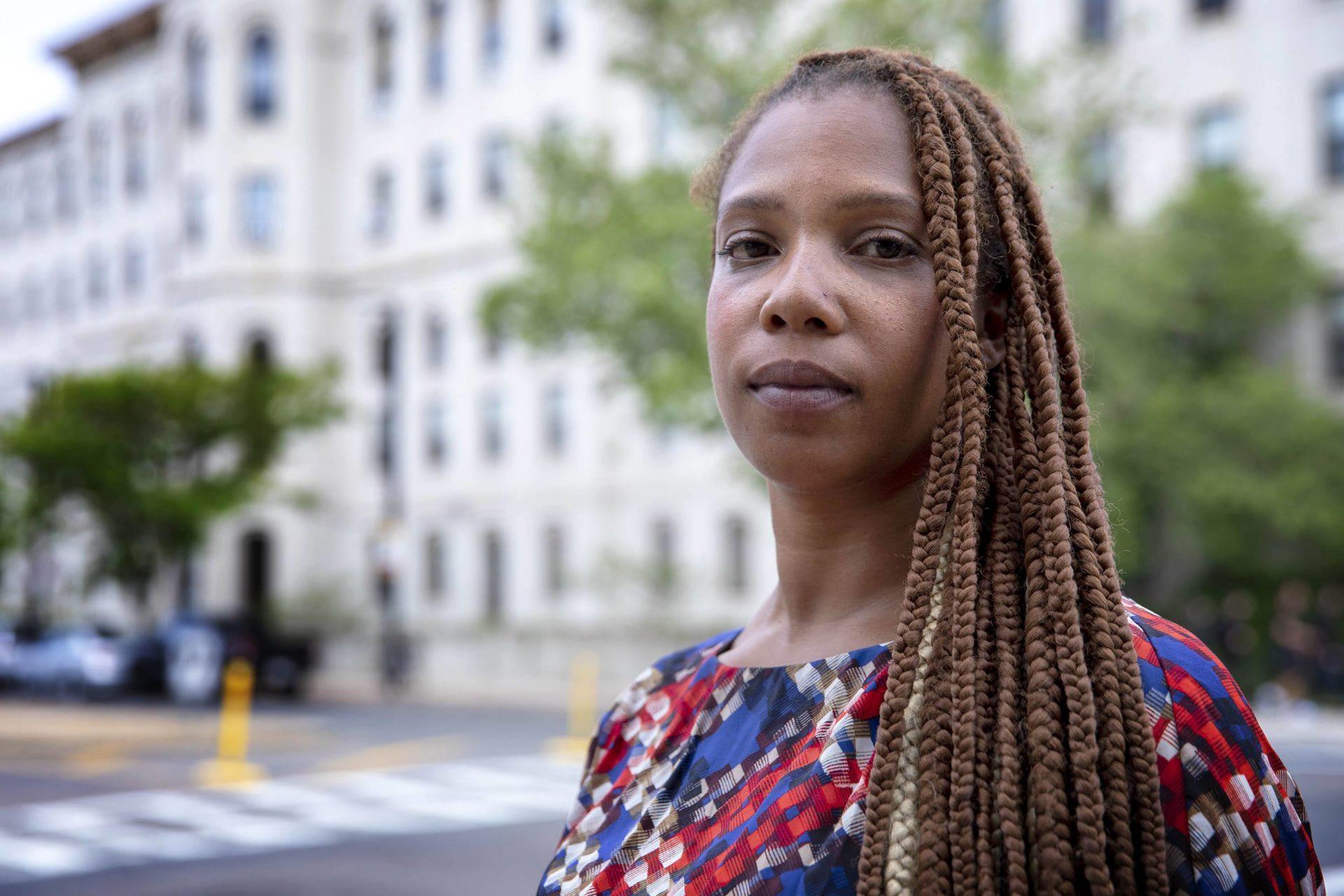
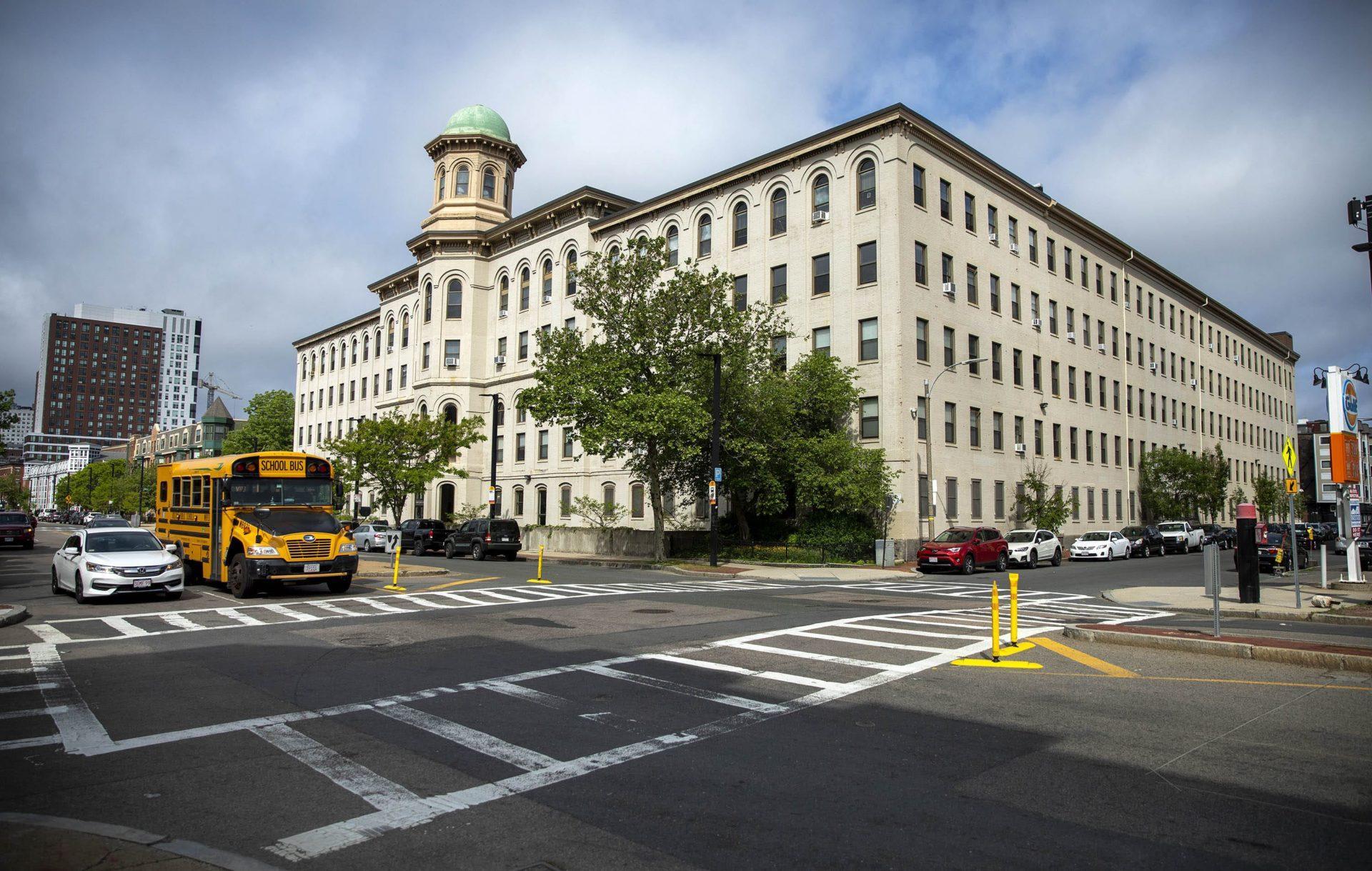
NeighborhoodHealthEquity
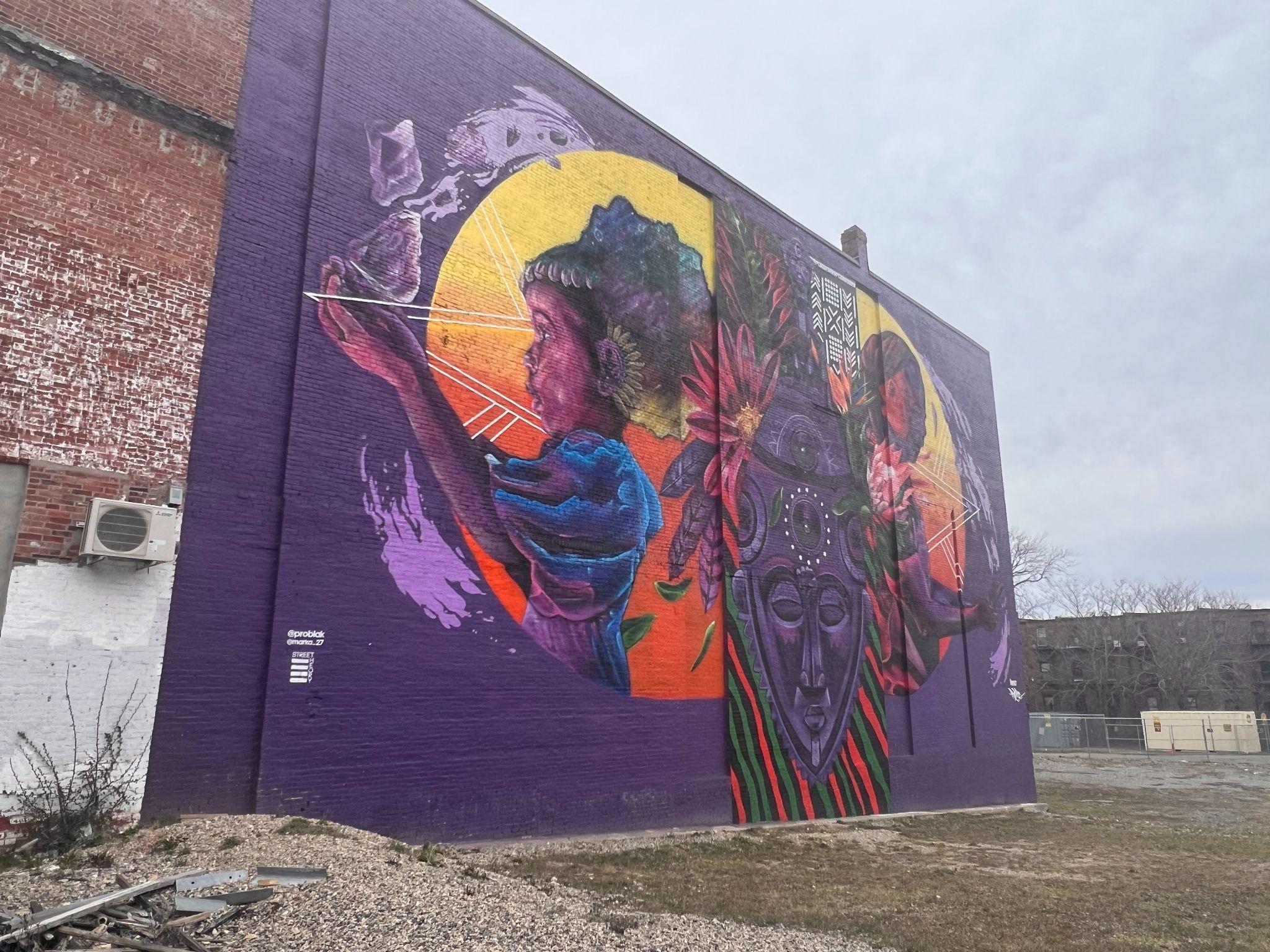
AccordingtotheHealthofBoston2016-2017,violenceandintentionalinjuriesare higherinDorchester,Roxbury,andSouthEndthanintherestofBoston(BostonPublicHealth Commission,2019).Theeffectsofviolenceintheseneighborhoodsareevidentinaresponse providedbyLetiaLarok,avocalistandsongwriterfromRoxbury,whichdescribeshowmental healthchallengescandevelopinthesecommunities:
Asfarasourcommunityspecifically,andtheriseinviolence,Ifeellike,youknow,just evengoingthroughcertaintraumasoflosinglovedones,andcontinuouslylosingloved ones…Ifeellikethere'salsoalackoftrustinourcommunity.Ithinkbecause,youknow, alotofthesehomicidesareunsolved.
Cheryl Jean, Director of the Lower Coalition and Wellness Initiative located at Whittier Health Center, voices her concerns about the frequency violence. For her, “it's hard, it gets harder and harder you have to with violence, and how it gets closer and to home.” Along with the worries of violence, the safety of Roxbury, the neighborhood where event Olawumi Akinwumi grew up, for its residents is worrisome. Considerherthoughtexperiment:
If we're gonna get more open green space for for the kids, what does that look like? Is it gonna safe? Is it gonna be clean? Because when you certain neighborhoods, and you want to outdoor event, you're like, yeah, I could do it in Jamaica Plain, because I don't have to worry about needles…When youcomeinRoxbury,wedon'thave anyopenspace.Andifwedo,it'snotclean.
AsimilarsentimentissharedbyLarok.Inresponsetowhatisimportanttoher community,Larokrespondswith “Iwouldjustliketoseeourneighborhoodsjustbemoreof whatitusedtobeatonepoint,youknow,seeingmorechildrenatparks,youknow,seeingmore, moreofourcommunitybeingabletofreelygooutandnothavetoworryabouttheirsafety.”A representativeatacommunityhealthcenterwhowishestoremainanonymoussumsuptheidea ofsafetyandviolenceinneighborhoodsexperiencinginequitablehealthoutcomes:
Ialsothinkintermsofpredominantneighborhoodconcerns,it'ssafety.Andthat encompassesalotofdifferentaspectsofsafety Intermsofviolence,aswellaskindof infrastructure,right,likesidewalksandparksanddifferentthingslikethat.
Providingopportunitiesforartistsofcoloriscrucialinthesolution-buildingprocessof publichealth.Astheonesexperiencingnumerousinequitablehealthoutcomes,communitiesof colorbenefitfromtheworkofartistsastheyareequippedtoarticulatehealthdisparitiesinways thatdatafromtheBostonPublicHealthCommissionstrugglestocaptureinmeaningfulways.
SocioeconomicConditionsforArtistsofColor
Itisclearfromtheinterviewsthatartistsofcolorarenotcompensatedequitablyfortheir work.Forexample,ShirleyFangexplainsthat“whileIseemyselfasanartist,Ihavenotmade enoughto,forittobealivableincome.”Self-proclaimed“artivist”AmandaSheafurther explainstheimportanceofjustcompensationforartists:
Wecan’tstarveartists.DoIknowwhatastarvingartistlookslike?Yes,becauseIwasa starvingartistinthebeginning.However,you'reneverstarvingifyou'reanartistbecause youhavetheabilitytocreatesomanydifferentwaysofmakingmoneythatit'sendless, really [But]ifyou'restarving,thenthatmeansthatyou'renotcreating.
InorderforartistsinRoxburytobeabletostayandthriveintheirneighborhood,Tania Andersonthinksthat“theyneedsomesortofmoney,right,grantsandthattheycanactuallyrun abusiness,notsomemeasly$5,000.”Expandingontheopportunitiesthatarenecessaryfor artiststothrive,AmandaSheasays,“thecitycangiveusmorefunding,securehousing opportunitiesforartists,andalsofellowshipsandsponsorships,youknow,likesponsorshipsare reallyimportant.” Forartiststothriveintheirneighborhoods,long-lastingopportunitiesand “somethingthat'seconomicallysustainable,”accordingtoJapyix,areneeded.Fairandjust compensationforartistswillbeachievedwhenconditionsaremetforthemtothrivewhich includessecureownershipofspacesuchasstudioandhousingopportunities.EphSeedescribes whathasledtothecurrentconditionsforartists:
…somethinghasshifted,wherethevalueofarthasgonedown,orthelegitimacyofart's powerhasbeendisputed,anddebatedin,youknow,courts,andthefirstprogramsthat arecutareartsprograms,becausethey'renotseenasessential.
ShirleyFangprovidesinsightintowhataworldwithabundantresourcesforartists wouldlooklikewhentreatedasessential:“Whenwe'renotrestrictedbyscarcity,themental capacitywehavetoexploreabundanceislike,infinite.”Inasimilar,hopefulspirit,EphSee reflectsonthepossibilitiesforthefutureoftheworkofartists:“SoIthinkrespectfortheartist willdefinitelyleadto,orshouldleadtoartistsgettingwhattheyneedtokeepmakinganart. Becauseweneedartists,whetherweliketoadmititornot,weneedthem.”
Theinterviewtranscriptsrevealthat,evenwhenartistsarebornintoeconomicstability,it iscommonforartistsofcolortoexperienceeconomichardship.Alloftheartiststhatwere intervieweddiscussedsomesortofincomeinsecurityandafewsharedtheirexperienceswith housinginsecurity.Institutionalracismisadrivingforceaffectingthepoliciesandthe opportunitiesthatareavailabletocommunitiesofcolorinBostonaswealth,privilege,and educaitondonotalwaysleadtoeconnomicstabilityforartists.
FutureResearchDirections
Partneringartistsandartorganizationswithstakeholderssuchasacademicinstitutions, publichealthagencies,andcommunityhealthcenterstocreatepublichealthsolutionsisa priority EphSeedescribestheimportanceofhowtheculturalecosystemintheirneighborhood benefitsthewell-beingoftheresidents:“Wehavesomuchtalentinourcommunity,andwhynot bringthattotheforefrontinthespacethat'screatedspecificallyfortheseartiststoexpress themselvesandatthesametimetocreatehealing.”Thebestsupportforartistswillcomefrom solutionsthatareinspiredbytheirvisions.Thus,itisimperativetoprioritizeartistsas co-researcherswhenlookingatthewaysartistsaffectthehealthoftheircommunities.
InresponsetoadiscussionontheculturalecosysteminBlackBostonneighborhoods, OlawumiAkinwumisays“Andthefactthatwehavesomanymediumsofartistryhere,whether it'sclassical,dance,choral,fromvisualtheater,younameit,likeeverybody'slookingforan opportunityorchancetoshineorhavetheirvoiceheard.”Thereisanabundanceofcreative talentinBlackBostonneighborhoods;however,theindividualsarenotvaluedbyinstitutional stakeholdersnearlyasmuchastheyshouldbefortheessentialworkthatisbeingdone.
OurresearchteamplanstoexplorefundingopportunitiesandwillapplyfortheRobert WoodJohnsonFoundation's"PioneeringIdeas:ExploringtheFuturetoBuildaCultureof Health"Grantin2023.Throughthisgrant,wehopetosupportfaircompensationforcommunity co-researchers(artistsandcommunityhealthcenteremployees);graduateresearchand undergraduateco-opappointmentsforresearchorganizationandmanagement;andfinancial supportforfacultyinvolvedwiththeproject.Goingforward,wealsoplantoengagegrantmakers throughouttheresearchprocesstobestinformhowartistsandcommunitiesbenefitfromthe grantsthatareofferedtothem.
Ourteamisworkingoncatalogingtheabundanceofculturalassets,asdescribedby Akinwumiabove,inBoston.Sofar,wehavemappedtheculturalecologyofourfivefocus neighborhoods.Thisincludesthelocationofpublicart—statues,murals,andotherpermanentor semi-permanentinstallations—andartsorganizations—museums,theatres,studios,artsretail shops—usingonlinedirectories,likeNortheasternUniversity’sArchivesandSpecialCollections andtheBostonResearchCenter,ourconversationswithartistsandartsadministrators,and neighborhoodwalks.ThismapwilleventuallybeexpandedasanArcGISstorymapwhereeach pinwillbecatalogedtoindicatetheasset’sculturalrelevancetocommunitiesofcolor,coded accordingtotheartist’sidentityorcommunityrelationships,andasconfirmedbyourcohortof consultingartists.
RECOMMENDATIONS
➢ Considerartistsasessentialpublichealthworkers
- Art and culture serve as protective health factors. Investments in public infrastructure needtoprioritizeaccesstoartandcultureprogramsinBIPOCcommunities.
- Public healthresearchmethodsshouldincludeartistsaspartnerswheretheyareequitably compensatedfortheirexpertise.
- Artists of color can provide trauma-informed care and lead the community in healing spacessuchascommunity-basedexhibitionsandarttherapyservices
➢ PrioritizeartandcultureinitiativesforBIPOCcommunities
- Social prescription programs,asoutlinedintheCultureRxprogram,forneighborhoodsin Boston experiencing health disparities should be created and driven by community organizersandartistsofcolor
- BIPOC artists need to beindiscussionsonartandhealth.Inaroundtablediscussionwith the National Endowment for the Arts in 2022, Aziza Robinson-Goodnight was the only Black artist in the room. Discussions like these need to be more intentional in including historicallyunderrepresentedvoices.
- Arts and culture leadership need to look like the residentsintheneighborhoodsthatthey serve.
➢ Increasecollaborationsbetweencommunityhealthstakeholders,artists,and publichealthresearchers
- Createopportunitiesforcollaborationbetweenartists,artstudios,communityhealth centers,Bostonpublichealthagencies,andpublichealthresearcherstolearnfromeach otherabouttheroleartistsplayincreatinghealthycommunities.
- Investincreativehubsincommunityhealthcentersforpatientsandhealthworkers.For example,co-locatingartsprogramsincommunityhealthcenterscanpromotethe well-beingofthecommunity.
➢ Assistartistsinaccessinggrantsandstudiospace
- EarmarkgrantsforartistsofcolorinBoston.InFebruary2023,theMassCultural Councilannounced$51millioninpublicgrantsinvestinginthecreativeandcultural sector,butonly15%ofthegrantmoneywenttoBIPOCorganizations(Steiner,2023). Grantmakersneedtomakesurecreativeandculturalgrantsmakeitintothehandsof BIPOCartistsas15%isunacceptable.
- Improvegrantaccessibilityforartistsofcolorsothattheapplicationprocessisnota barriertosuccess.
- AdvertisegrantssothattheopportunitiesreachBIPOCcommunities
- TheCityofBostonneedstoadvanceeffortstoprovidestudiospaceforBIPOCartists.A groupofaround40artists,withthehelpofdevelopersandthecityofBoston,bought HumphreyStreetStudiosinDorchestertoavoidinvoluntarydisplacementduetobeing pricedoutoftheirstudios(Mason,2022b).Inthiscase,thephysicalworkingspacefor artistswillbepreservedforartistsinthisneighborhoodandisanexampleofhowto avoidthedisplacementofartists.
- IncentivizestakeholdersinBostontoprovidephysicalspacethatcanserveasstudio spaceforartistswhilesimultaneouslyprovidingalocationforthepublictoexperienceart forhealingandwell-beingpurposes.
- Developahubforcreativeexpressionthatprioritizesthehealthandwell-beingofthe community.TheRhodeIslandArtsandHealthNetworkhasoutlinedtheworkingvision andcorevaluesforathrivingartsandhealthcommunityinRhodeIsland(RhodeIsland ArtsandHealthNetwork,2020).Bostonpublichealthagencies,practitioners,funding andadvocacypartners,andculturalgroupsmayfindtheseideasusefulindevelopinga culturalhubinBoston.
➢ EncouragerealestateandlandownershipinBostondedicatedtoco-locating artandhealthpromotion
References
Bader,R.,Wanono,R.,Hamden,S.,&Skinner,H.A.(2007).Globalyouthvoices. Canadian Journal of Public Health,98(1),21–25.https://doi.org/10.1007/bf03405379
Bitonte,R.A.,&Santo,M.D.(2014).Arttherapy:Anunderutilized,yeteffectivetool. Mental Illness,6(1),18–19.https://doi.org/10.1108/mi.2014.5354
BostonIndicators.(2019). Changing Faces of Greater Boston.BostonIndicators.Retrieved February4,2023,from
https://www.bostonindicators.org/reports/report-website-pages/changing-faces-of-greaterboston
BostonPublicHealthCommission.(2019).HealthofBoston2016-2017.CityofBoston.
RetrievedMarch9,2023,from
https://www.boston.gov/sites/default/files/file/2021/03/_HOB_16-17_FINAL_SINGLE% 20PAGES-Revised%20Feb%202019.pdf
CityofBostonMayor'sOffice.(2020,June12).MayorWalshdeclaresracismapublichealth crisis.Boston.gov.RetrievedFebruary8,2023,from
https://www.boston.gov/news/mayor-walsh-declares-racism-public-health-crisis
Junge,M.B.(2016).Historyofarttherapy. The Wiley Handbook of Art Therapy, 7–16.
https://doi.org/10.1002/9781118306543.ch1
Kewley,S.,&VanHout,M.C.(2020).“I’dprobablybedeadnow”:Evaluatingtheimpactof theatrepractitionersworkingonarecovery-basedCommunityDramaProject.
International Journal of Mental Health and Addiction, 20(2),1212–1230.
https://doi.org/10.1007/s11469-020-00437-3
MassCulturalCouncil.(2022,June15).CultureRxInitiative.MassCulturalCouncil.Retrieved March28,2023,fromhttps://massculturalcouncil.org/communities/culturerx-initiative/
Mason,A.(2020,June29).BlackartistcollectivelockedoutofstudiosatNortheastern University WBURNews.RetrievedFebruary26,2023,from
https://www.wbur.org/news/2020/06/29/black-artist-collective-locked-out-of-studios-at-n ortheastern-university
Mason,A.(2022,June22).InBoston,ataleoftwoartsdistricts.WBURNews.RetrievedApril 9,2023,from
https://www.wbur.org/news/2022/06/22/sowa-art-nubian-square-development
Mason,A(2022,November10).ArtistspurchaseHumphreysStreetStudios,withhelpfroma developerandthecity.WBURNews.RetrievedApril12,2023from
https://www.wbur.org/news/2022/11/10/artists-purchase-humphreys-street-studios
RhodeIslandArtsandHealthNetwork.(2020).ACenterforArtsandHealthinRhodeIsland. RhodeIslandArtsandHealthNetwork.RetrievedApril12,2023from
https://health.ri.gov/materialbyothers/reports/RIAHN-studio-report-2020.pdf
Sonke,J.&Golden,T.(2020).ArtsandCultureinPublicHealth:AnEvidence-Based
Framework.TheUniversityofFloridaCenterforArtsinMedicine
Steiner,B.(2023,February15).MassCulturalCouncilCelebrates$51MinCulturalSector
PandemicRecoveryGrants.MassCulturalCouncil.ReetrievedApril12,2023,from https://massculturalcouncil.org/blog/mass-cultural-council-celebrates-51m-in-cultural-sec tor-pandemic-recovery-grants/
AppendixA
COVID-19NeighborhoodOutcomes(BPHC)
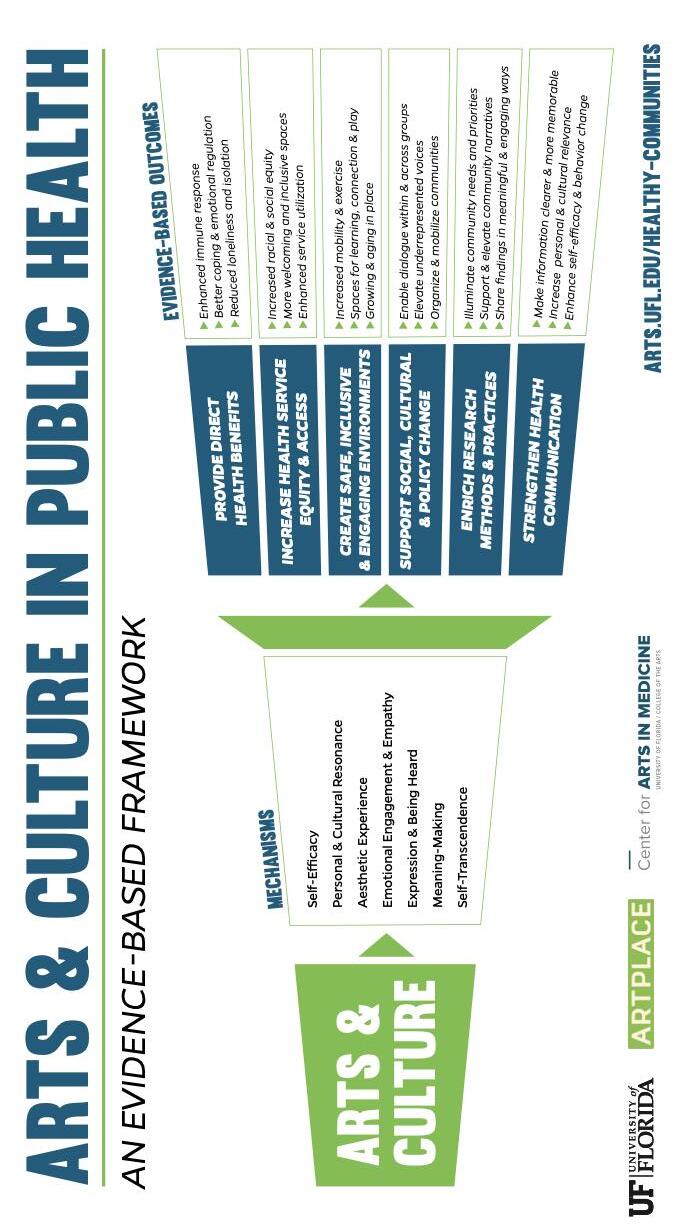
AppendixC
ArtistInterviewQuestionBank
1.Howdoyoudescribeyourraceorethnicity?
1a.Related/alternative:Whatother/Whichcommunitiesdoyouidentifywith?
2.Howwouldyoudescribeyourart,orwhereyoufitinthecreativeworld?
2a.Related/icebreaker:Whatareyourcreativemediums/subjects?Whoareyour contemporaries?
3.Howwouldyoudescribetheneighborhoodsyouliveandworkin?
3a.Related:Whataretheirborders?Whomakesuptheseneighborhoods?
4.Whatmakestheseneighborhoodsspecial?
5.Whatchangesorchallengeshavetheseneighborhoodsfacedinyourlifetime/timelivingand workingthere?
5a.Follow-up:Whatarethefactorscontributingtothesechangesandchallenges?
6.Howhaveartists(or:Howhasyourart)contributedtotheneighborhoodswhereyoulive/work
6a.Related:Haveyou/theycontributedpublicwork/education?
6b.Follow-up:Haveyou/theyparticipatedincommunitydevelopment/community organizing?
7.Howwouldyoudefineahealthycommunity?
8.Howdoyouimagineartmightcontributetothehealthofyourcommunities?
9.WhatarethebiggestchallengesyoufaceasanartistinBoston?
10.WhatdoyouwanttheCityofBostontodotobettersupportitsartistsandcommunities?
11.Whoelsedoyourecommendthatwespeakwithduringthisresearch?
12.Whatelsedoyouhopewewillaskinthefuture?
AppendixD
ArtsLeaderInterviewQuestionBank
1.Howdoyoudescribeyourraceorethnicity?
1a.Related/alternative:Whatother/Whichcommunitiesdoyouidentifywith?
2.Howwouldyoudescribeyourcollection/programming?
3.Howwouldyoudescribeyouraudience?
3a.Clarifying:Whomakesupthemajorityofyouraudience?Areyoureachingdiverse audiences,intermsofrace/ethnicity,age,etc.?
3b.Follow-up:Areyoureachingtheaudiencesyouhopeto?
4.Howwouldyoucharacterizeyourrelationshiptotheneighborhoodwhereyourinstitutionis located?
4a.Related:Couldyoudescribeyourcommunityoutreachactivities?
4b.Follow-up:Howmightyouimproveyourcommunityoutreach?Whatresourcesor knowledgewouldthisrequire?
5.Howwouldyoudefineahealthycommunity?
6.Howdoyouimagineartsorganizationsmightcontributetothehealthofyourcommunities?
7.Howhasyourworkchangedoverthelastyear,asaresultofa)thepandemicandresulting shutdownsandb)thesurgeofsupportforracialjustice,followingtheeventsoflastSpringand Summer?
8.Whatarethebiggestchallengesyourorganizationfaces?
9.WhatdoyouwanttheCityofBostontodotobettersupportitsartistsandartsorganizations?
10.Whoelsedoyourecommendthatwespeakwithduringthisresearch?
11.Whatelsedoyouhopewewillaskinthefuture?
